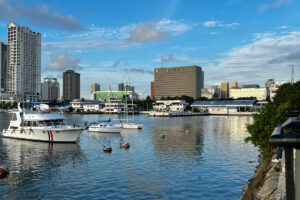Grounds for cautiousness: Regional economic and financial stability
(Second of two parts) If there’s any big conglomerate that has been quite forthright with its cautious assessment of growth prospects in 2024, it must be the SM Group, represented by the vice-chair of the shopping mall and SM Investment Corp. (SMIC) Teresita Sy-Coson. Despite their phenomenal profitability courtesy of both BDO and SMIC, Ms. […]

(Second of two parts)
If there’s any big conglomerate that has been quite forthright with its cautious assessment of growth prospects in 2024, it must be the SM Group, represented by the vice-chair of the shopping mall and SM Investment Corp. (SMIC) Teresita Sy-Coson. Despite their phenomenal profitability courtesy of both BDO and SMIC, Ms. Coson opted for guarded optimism due to what she called spiking tension in the West Philippine Sea which all started in April 2012.
“Left to ourselves, we are going to do well but there are geopolitical tensions and climate change… I think our group assessment is we are going to be okay but we just have to be watchful.”
Of course, the SM Group’s concern over the West Philippine Sea row is focused on it being just another manifestation of the US-China geopolitical rivalry. This assessment is quite close to what we hear from Beijing. But already, China has been busy initiating what amounts to actual incursions into the Philippines. We read this from the academe, the broadsheets and social media, and these are all based on the Philippine Government’s official account of what is unfolding in the West Philippine Sea without very much calling it invasion.
If it’s a simple word war between these two remaining superpowers, it could be a protracted but perhaps less serious global concern. In all likelihood, we believe both parties do realize that it’s less costly that way while exacting their own pound of flesh from those directly or indirectly involved in the fray. Incremental incursions are less obvious but effective in territorial expansion. It’s more cost-effective to make noise than fire those missiles. But quietly, China has been defying the international court ruling on the West Philippine Sea by building their own infrastructure in Philippine territories and preventing, by using water cannons, the Philippines from securing its own legal territories.
And literally, China has been able to possess and keep those Philippine Islands and maritime zones regardless of world opinion by sheer military assertion. Under this scenario, the situation could be riskier because the impact could be more real than a simple word war. We don’t know if China is aware of its own constitution which stipulates in Article 5 that it “shall practice law-based governance and build a socialist state under the rule of law.”
AMRO REGIONAL ECONOMIC OUTLOOK
In the recent presentation of the AMRO Regional Economic Outlook (AREO) in Japan this month, it looks like everything seems to be normalizing. But in the concluding portions on the regional risk map, we notice that US-China geopolitical tension was cited as one of the risks. However, this is classified under medium-term imminence, something that should concern us not now but in the next two to five years, with a low level of likelihood.
Short-term risks include a spike in global commodity prices with a medium level of likelihood which may be concerning, as well as financial spillovers from tighter US monetary policy, slower economic recovery in China, and recession in US and Europe —all with a low level of likelihood.
In short, what is happening in the West Philippine Sea may be unique to the Philippines because it is our own territories that are being claimed and virtually annexed to China. If we contextualize the risks to the Philippines, are we not justified to consider it an immediate concern with a higher level of likelihood it would happen, and instead of a general euphemistic “US-China geopolitical tension” the risk could be one of aggression? If our small islands and our exclusive economic zone in the West Philippine Sea are considered part of the Middle Kingdom, what prevents anyone from including Luzon, Visayas, and Mindanao?
In fact, AMRO’s assessment of risks for the Philippines simply reflects its own risk assessment for the region. Heightened geopolitical risks are listed as medium-term concern with low level of probability.
As for the rest of the ASEAN+3, the latest available data shows that, given those risks, the prognosis seems to have improved. The advanced economies continue to grow based on manufacturing and services. It is also encouraging to see both headline and core inflation in the US and Europe sustaining their downtrends. While China receives some boost from its fixed investment, industrial profits, and real consumer spending, its recovery is rather slow compared to expectations, particularly if the global economy remains more fragmented.
AMRO pins its hopes on the strength of domestic demand to sustain economic growth in the region. For instance, household spending has been holding due to strong employment conditions and rising household income. On the part of business, retail sales are improving as travel and tourism continue to recover.
AMRO cites S&P data and staff calculations to point out that the recovery in manufacturing in ASEAN+3 shows some softening in recent months. In Asia, the sectoral Purchasing Managers’ Index (PMI), especially in automobiles and auto parts as well as in industrial machinery, indicates a similar trend. Manufacturing activities are not getting more entrenched.
Exports appear to be looking up, with the rate of contraction slowing down. Some benefits may be forthcoming from the expected turnaround in the technology cycle and tourist business. This should be positive for the Philippines because exports of goods which account for nearly 18% of GDP had been declining in the first 10 months of the year.
Finally, if the US continues its monetary policy on a “higher for longer” path, and commodity prices spike again, exchange rate weakening in the region could only frustrate the moderating inflation trend. This is sobering, and this should make us more cautious in assessing economic prospects.
AMRO FINANCIAL STABILITY REPORT
The AMRO Financial Stability Report (AFSR) runs along the same track.
It was correct for its inaugural issue this month to have pointed out that the global financial conditions “oscillated between tightening and easing, underpinned by shifting monetary policy stances by global central banks amid COVID-19 pandemic, higher inflation, and geopolitical events.” Liquidity stress continued to mount, especially in the US which was hit by some banking crisis.
It was unavoidable that the favorable conditions of low inflation and low interest rates should yield to the challenges of high inflation and high interest rates. As this regime got entrenched through 2023, the world’s economic regions have to grapple with the spillover effects. It is good that we are starting to see inflationary pressures ease, external buffers improve, and monetary policy and non-monetary measures deliver gradual price stability. The AFSR called this aspect of financial stability under multiple trials.
But the Report also likened us to drivers navigating in low visibility. More favorable inflation conditions may be forthcoming, but this is riddled by the uncertainties in the labor market, the lagged impact of previous inflationary situation, and the potential commodity price surges. It would be a tough act managing inflation, promoting economic growth, and safeguarding financial stability.
For many countries in the region, their next monetary policy stance could be largely anchored on what the US Fed might do in the near future. Decoupling is not feasible at this time because the world remains interlinked and connected. Therein lies another instance of low visibility.
A good analytical transition, this AFSR discussion of higher debt following an era of ample liquidity and pandemic funding needs. The pandemic made it imperative for governments across the region, and elsewhere, to extend monetary and fiscal stimulus measures. With practically zero growth, the official capacity to sustain public spending could only be achieved by higher borrowings.
And the numbers are very sobering.
The region’s total debt-to-GDP ratio, inclusive of corporate, household and public debt, peaked at 325% during the pandemic before declining to 299% at the end of 2022. As we wrote last week, it is true that AMRO’s stress tests show that fiscal sustainability and financial stability “may not exactly be in clear and present danger,” it is important for the authorities to realize that “if allowed to accumulate more, and at more rapid pace, the debt issue could graduate to the front and center of public policy concern.”
POLICY OPTIONS
We can be parsimonious in citing the policy recommendations of AMRO: ASEAN+3 central banks should prioritize the fight against inflation; regular liquidity facilities should be made available for banks; a wide range of macroprudential tools should be deployed to address various sources of risks from household and corporate debts including from property development; a medium-term fiscal consolidation plan embracing a possible fiscal rule and public debt management strategy to mitigate public debt; keeping banks’ leverage ratios to ensure stable financial intermediation and economic growth.
Yes, unique local factors may be more dominant in driving economic growth and financial stability, but in some instances, global and regional drivers could be more binding. Since these are mostly outside our control, there is always a room for us to keep watch and pray.
A blessed Christmas to all!
Diwa C. Guinigundo is the former deputy governor for the Monetary and Economics Sector, the Bangko Sentral ng Pilipinas (BSP). He served the BSP for 41 years. In 2001-2003, he was alternate executive director at the International Monetary Fund in Washington, DC. He is the senior pastor of the Fullness of Christ International Ministries in Mandaluyong.














